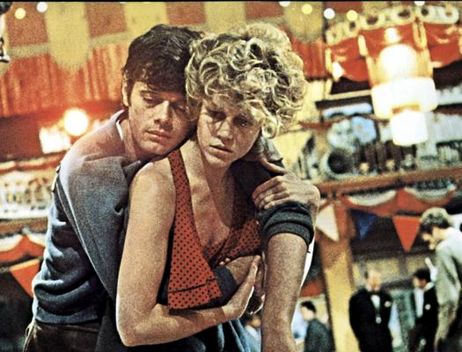 |
| Anthony Perkins in Orson Welles' "The Trial" |
This week, my brain found a way to actually connect the subjects of "Franz Kafka", "Britney Spears", "Orson Welles" and "Glee" within the same thought. To be clear, the connection was from a visually interpretative perspective...not so much in shared ideals, behaviors and talents between these four icons.
Here's the source of this random connection:
While watching Welles' 1962 adaptation of Kafka's The Trial, there is a brief, nightmarish sequence during the film's climatic pitch that caused my attention to falter and fail. Thinking I was completely immersed within the dreamy existentialism and social satire of Kafka's interpretation of a man cornered by the justice system without logic or clarity of his crimes, my attempt to concentrate on the sophisticated content was rudely pinched by that part of my brain that has been completely corrupt by mainstream pop.
First off, I've yet to really read Kafka's The Trial so my commentary and observation is more about the film's visuals and style as opposed to the philosophical context that has been adapted from its literary origin; I try to follow the philosophy "first the original, then the adaptation" when it comes to media, even if the latter trumps the former in quality. Obviously, in this scenario, I've failed this mantra completely.
The cinematic version of The Trial leans gluttonously heavy (in a good way) on set design, lighting, mirrors and camera placement, depicting surroundings of claustrophobic minimalism to a rich, stylistic interpretation of a hoarder's dream: stacks of overflowing files, cabinets, papers, weighty furniture and crowds, packed underneath an infinitely unseen ceiling. Just watching the film makes you feel like you're in a hazardous, death trap with no exit (many of the scenes are literally how I envisioned the last chapter of E.L. Doctorow's Homer & Langley).
The scene that triggered my cross-media ADD was the moment after the main character, Josef K. (Anthony Perkins) goes to visit the painter Titorelli who, with farcical intent, is consider a close associate of the judicial system. In the book, Titorelli lives in the attic of some form of projects littered with loitering, hunchbacked children who jokingly harass the painter through the walls of loosely bound wood planks.
Here is the description from the book:
...K. had been looking round the room, if it had not been pointed out it would never have occurred to him that this wretched little room could be called a studio. It was hardly long enough or broad enough to make two steps. Everything, floor, walls and ceiling, was made of wood, between the planks narrow gaps could be seen.
Here is Welles' interpretation of Titorelli's studio and the winding, rickety-looking hallway that Josef stumbles through when leaving the painter:
And this is the moment where I made the inattentive connection: this literally looks just like that Britney Spears music video.
Skeptical of this comparison? Have a look a look at Spears' video, "Me Against the Music":
And as redone in the Britney-tribute episode of Glee:
-MTK













2.jpg)









